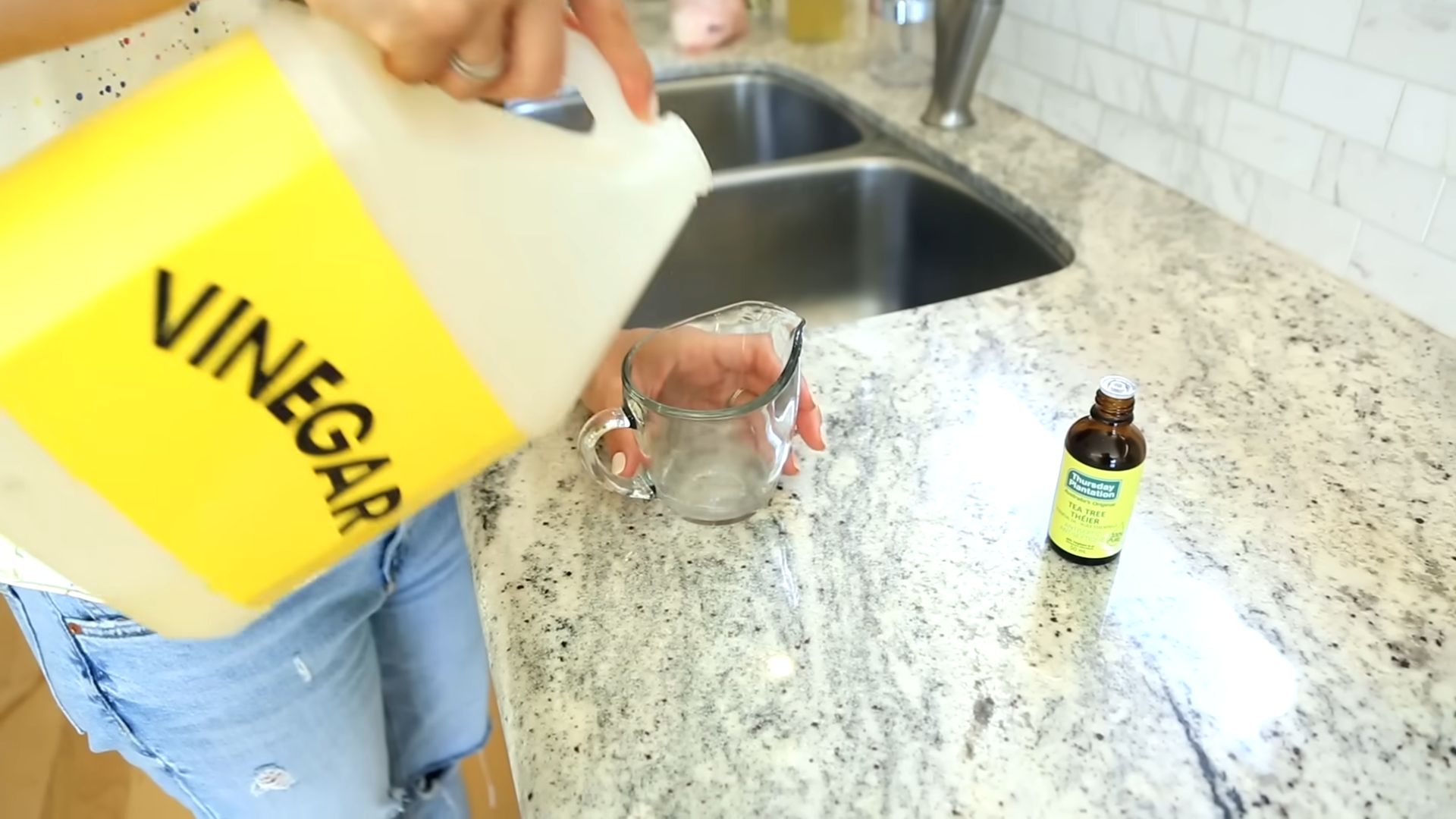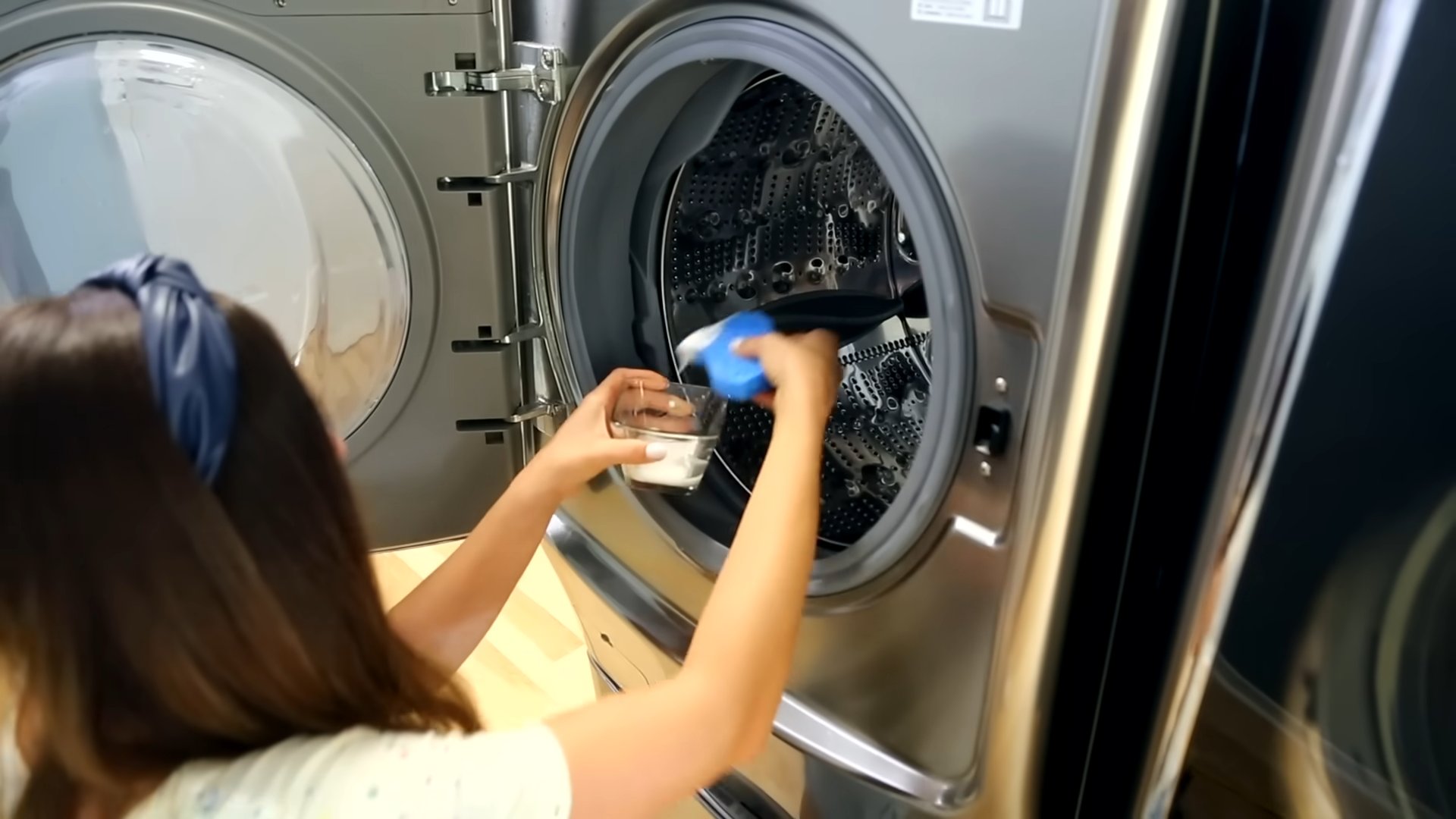Clean Washing Machine Naturally – sounds like a dream, right? I know, I know, cleaning appliances isn’t exactly anyone’s favorite pastime. But trust me, this is one DIY project that will pay off big time! Think about it: your washing machine is responsible for keeping your clothes fresh and clean, but over time, it can become a breeding ground for mold, mildew, and lingering odors. Yuck!
For centuries, people have sought natural ways to maintain cleanliness. Before the age of harsh chemicals, our ancestors relied on the power of simple ingredients like vinegar and baking soda – the very same ingredients we’ll be using today! This isn’t just about nostalgia; it’s about creating a healthier home environment and extending the life of your appliances.
Why is this DIY trick so essential? Because a dirty washing machine doesn’t just smell bad; it can actually reduce the effectiveness of your laundry detergent, leaving your clothes less clean than you think. Plus, all that gunk can damage your machine over time, leading to costly repairs or even replacement. I’m going to show you how to clean washing machine naturally, easily, and affordably, so you can keep your clothes sparkling and your machine running smoothly for years to come. Let’s get started!

DIY: Sparkling Clean Washing Machine (Naturally!)
Okay, let’s be honest, cleaning the washing machine is probably the last thing on your mind. But trust me, a clean washing machine means cleaner clothes and a longer lifespan for your appliance. Plus, it’s way easier than you think, especially when you ditch the harsh chemicals and go the natural route! I’m going to walk you through my favorite method for getting your washing machine sparkling clean using ingredients you probably already have in your pantry.
Why Clean Your Washing Machine?
Before we dive in, let’s quickly cover why this is so important. Over time, your washing machine accumulates:
* Detergent Residue: Even with HE detergents, residue can build up, creating a breeding ground for bacteria and mold.
* Fabric Softener Buildup: Fabric softener is notorious for leaving a sticky film that attracts dirt and grime.
* Hard Water Deposits: If you have hard water, mineral deposits can clog your machine’s components.
* Lint and Debris: No matter how careful you are, lint and small items can find their way into your machine.
* Mold and Mildew: The damp environment inside your washing machine is perfect for mold and mildew growth, leading to unpleasant odors.
All of this can lead to smelly clothes, reduced cleaning performance, and even damage to your washing machine. So, let’s get cleaning!
What You’ll Need
Here’s what you’ll need to get started. Don’t worry, it’s all pretty basic stuff:
* White Vinegar: This is our star ingredient! Vinegar is a natural disinfectant and deodorizer.
* Baking Soda: Baking soda helps to scrub away grime and neutralize odors.
* Microfiber Cloths: These are great for wiping down surfaces without leaving streaks or lint.
* Old Toothbrush: Perfect for scrubbing those hard-to-reach areas.
* Spray Bottle: For easy application of vinegar.
* Rubber Gloves (Optional): If you have sensitive skin, gloves are a good idea.
Cleaning a Top-Loading Washing Machine
Let’s start with top-loading machines. The process is slightly different for front loaders, so we’ll cover that next.
Step 1: The Vinegar Wash
1. Empty the Washing Machine: Make sure there are no clothes or other items inside.
2. Set the Water Level: Choose the highest water level setting.
3. Add Vinegar: Pour 3-4 cups of white vinegar into the washing machine drum.
4. Run a Hot Water Cycle: Select the hottest water setting and run a complete wash cycle. This will help to loosen any buildup and kill bacteria.
Step 2: Baking Soda Soak
1. After the Vinegar Wash: Once the hot water cycle is complete, let the washing machine fill again with hot water.
2. Add Baking Soda: Add about ½ cup of baking soda to the water.
3. Agitate Briefly: Let the machine agitate for a minute or two to mix the baking soda.
4. Soak for an Hour: Turn off the machine and let the baking soda solution soak for at least an hour, or even overnight for heavily soiled machines. This will help to further break down any remaining residue.
Step 3: The Final Rinse
1. Drain the Soaking Solution: After the soaking period, drain the baking soda solution from the washing machine.
2. Run a Rinse Cycle: Run a complete rinse cycle with cold water to remove any remaining baking soda and loosened debris.
Step 4: Cleaning the Dispenser and Exterior
1. Remove the Dispenser: If your washing machine has a removable detergent dispenser, take it out.
2. Clean the Dispenser: Wash the dispenser with warm, soapy water. Use an old toothbrush to scrub away any stubborn residue. Rinse thoroughly and allow to dry completely before replacing it.
3. Wipe Down the Exterior: Use a microfiber cloth dampened with a mixture of vinegar and water to wipe down the exterior of the washing machine, including the lid, control panel, and any other surfaces.
4. Clean the Agitator (If Applicable): If your machine has an agitator, wipe it down with a damp cloth and use an old toothbrush to clean any crevices.
Step 5: Air Dry
1. Leave the Lid Open: After cleaning, leave the washing machine lid open to allow it to air dry completely. This will help to prevent mold and mildew growth.
Cleaning a Front-Loading Washing Machine
Front-loading washing machines require a slightly different approach due to their design.
Step 1: The Vinegar Wash
1. Empty the Washing Machine: Make sure there are no clothes or other items inside.
2. Add Vinegar to the Dispenser: Pour 2 cups of white vinegar into the detergent dispenser.
3. Run a Hot Water Cycle: Select the hottest water setting and run a complete wash cycle. If your machine has a “clean washer” cycle, use that.
Step 2: Baking Soda Paste
1. Make a Paste: Mix ¼ cup of baking soda with ¼ cup of water to create a paste.
2. Apply the Paste: Use a sponge or cloth to apply the baking soda paste to the inside of the washing machine drum, paying special attention to any areas with visible stains or residue.
3. Scrub Gently: Gently scrub the drum with the paste.
Step 3: Clean the Rubber Gasket
This is a crucial step for front loaders, as the rubber gasket is a prime spot for mold and mildew.
1. Inspect the Gasket: Carefully inspect the rubber gasket around the door for any signs of mold or mildew.
2. Spray with Vinegar: Spray the gasket with white vinegar.
3. Scrub with a Toothbrush: Use an old toothbrush to scrub away any mold or mildew.
4. Wipe Clean: Wipe the gasket clean with a damp microfiber cloth.
5. Dry Thoroughly: Make sure the gasket is completely dry to prevent future mold growth. You can use a dry cloth to wipe it down.
Step 4: Clean the Dispenser
1. Remove the Dispenser: If your washing machine has a removable detergent dispenser, take it out.
2. Clean the Dispenser: Wash the dispenser with warm, soapy water. Use an old toothbrush to scrub away any stubborn residue. Rinse thoroughly and allow to dry completely before replacing it.
Step 5: The Final Rinse
1. Run a Rinse Cycle: Run a complete rinse cycle with cold water to remove any remaining baking soda and loosened debris.
Step 6: Air Dry
1. Leave the Door Ajar: After cleaning, leave the washing machine door ajar to allow it to air dry completely. This is especially important for front loaders to prevent mold and mildew growth.
Cleaning the Drain Pump Filter (Important for Both Types!)
This is often overlooked, but it’s a vital part of maintaining your washing machine. The drain pump filter catches lint, debris, and small objects that can clog the drain pump.
1. Locate the Filter: Consult your washing machine’s manual to find the location of the drain pump filter. It’s usually located at the bottom front of the machine, behind a small access panel.
2. Prepare for Water: Place a shallow dish or towel under the access panel to catch any water that may spill out.
3. Open the Access Panel: Carefully open the access panel.
4. Remove the Filter: Slowly unscrew or pull out the drain pump filter. Be prepared for some water to come out.
5. Clean the Filter: Remove any lint, debris, or objects from the filter. Rinse it thoroughly with water.
6. Replace the Filter: Reinstall the clean filter and close the access panel.
Tips for Keeping Your Washing Machine Clean
Here are a few tips to help you keep your washing machine clean and prevent future buildup:
* Use HE Detergent: High-efficiency (HE) detergents are designed to produce less suds and residue.
* Use the Right Amount of Detergent: Using too much detergent can lead to buildup. Follow the manufacturer’s instructions carefully.
* Avoid Fabric Softener: Fabric softener can leave a sticky film that attracts dirt and grime. Consider using dryer balls instead.
* Wipe Down the Machine Regularly: Wipe down the exterior of the washing machine and the rubber gasket (for front loaders) regularly with a damp cloth.
* Leave the Door/Lid Ajar: After each use, leave the washing machine door or lid ajar to allow it to air dry completely.
* Run a Cleaning Cycle Regularly: Run a cleaning cycle with vinegar or a washing machine

Conclusion
So, there you have it! A simple, effective, and entirely natural way to keep your washing machine sparkling clean and functioning at its best. Forget harsh chemicals and expensive cleaning products. This DIY trick, using ingredients you likely already have in your pantry, is a game-changer for maintaining a fresh and efficient laundry routine.
Why is this a must-try? Because a clean washing machine isn’t just about aesthetics; it’s about performance and longevity. A build-up of detergent residue, hard water deposits, and mildew can significantly reduce your machine’s cleaning power, leading to dingy clothes and unpleasant odors. It can also strain the machine’s components, potentially shortening its lifespan and leading to costly repairs. By regularly cleaning your washing machine naturally, you’re not only ensuring cleaner clothes but also protecting your investment.
Beyond the basic recipe, there are several variations you can explore to tailor the cleaning process to your specific needs. For example, if you live in an area with particularly hard water, consider adding a cup of borax to the cleaning cycle for an extra boost in mineral deposit removal. If you’re dealing with a particularly stubborn mildew problem, pre-treating the affected areas with a paste of baking soda and water can work wonders. For a refreshing scent, add a few drops of your favorite essential oil (tea tree, lavender, and lemon are excellent choices for their antibacterial and antifungal properties) to the empty drum before running the cleaning cycle. You can also experiment with different ratios of vinegar and baking soda to find what works best for your machine and water conditions. Remember to always consult your washing machine’s manual before trying any new cleaning methods.
This DIY method to clean washing machine naturally is not only effective but also environmentally friendly. By avoiding harsh chemicals, you’re reducing your impact on the environment and creating a healthier home for yourself and your family. It’s a win-win situation!
We’re confident that once you try this simple DIY trick, you’ll be amazed by the results. Your washing machine will be cleaner, your clothes will be fresher, and you’ll have the satisfaction of knowing you’re using a natural and sustainable cleaning solution.
Don’t just take our word for it – give it a try! We encourage you to experiment with the variations, find what works best for your machine, and share your experience with us. Let us know in the comments below how this DIY cleaning method has transformed your laundry routine. We’re eager to hear your success stories and any tips you might have to share with the community. Let’s all work together to keep our washing machines clean and our laundry fresh, naturally!
Frequently Asked Questions (FAQ)
Why is it important to clean my washing machine?
It’s crucial to clean your washing machine regularly for several reasons. Firstly, detergent residue, fabric softener, and mineral deposits can build up over time, creating a breeding ground for bacteria and mold. This can lead to unpleasant odors and can even transfer to your clothes, making them smell musty even after washing. Secondly, a dirty washing machine is less efficient. The build-up of residue can clog the dispenser and hinder the machine’s ability to properly clean your clothes. Finally, neglecting to clean your washing machine can shorten its lifespan. The build-up of deposits can strain the machine’s components, leading to breakdowns and costly repairs. Regular cleaning helps maintain optimal performance and extends the life of your appliance.
How often should I clean my washing machine naturally?
The frequency of cleaning depends on how often you use your washing machine and the type of detergents and fabric softeners you use. As a general guideline, it’s recommended to clean your washing machine at least once a month. If you use your washing machine frequently or use a lot of liquid fabric softener, you may need to clean it more often, perhaps every two weeks. If you notice any unpleasant odors or see visible residue build-up, it’s definitely time for a cleaning.
Can I use this method for both top-loading and front-loading washing machines?
Yes, this DIY cleaning method is generally safe and effective for both top-loading and front-loading washing machines. However, there are a few slight adjustments you may need to make depending on the type of machine you have. For top-loading machines, simply pour the vinegar and baking soda directly into the drum. For front-loading machines, pour the vinegar into the detergent dispenser and the baking soda into the drum. Be sure to check your washing machine’s manual for any specific cleaning instructions or recommendations.
What type of vinegar should I use?
White distilled vinegar is the best choice for cleaning your washing machine. It’s inexpensive, readily available, and has a high acidity level, making it effective at dissolving mineral deposits and killing bacteria and mold. Avoid using other types of vinegar, such as apple cider vinegar or balsamic vinegar, as they may contain sugars or other additives that could leave a sticky residue in your machine.
Is baking soda really necessary? Can I just use vinegar?
While vinegar is a powerful cleaning agent on its own, baking soda adds an extra layer of cleaning power. Baking soda is a mild abrasive that helps to scrub away stubborn residue and deodorize the machine. When combined with vinegar, it creates a fizzing action that helps to loosen dirt and grime. While you can clean your washing machine with just vinegar, using baking soda in combination with vinegar will provide a more thorough and effective cleaning.
What if I have a particularly stubborn mildew problem?
If you’re dealing with a particularly stubborn mildew problem, you may need to take some extra steps. Before running the cleaning cycle, try pre-treating the affected areas with a paste of baking soda and water. Apply the paste to the mildewed areas and let it sit for at least 30 minutes before wiping it away. You can also add a cup of hydrogen peroxide to the cleaning cycle for an extra boost in mildew removal. In severe cases, you may need to repeat the cleaning process several times to completely eliminate the mildew.
Can I use bleach instead of vinegar and baking soda?
While bleach is a powerful disinfectant, it’s not the best choice for cleaning your washing machine naturally. Bleach can be harsh on the machine’s components and can also leave behind a strong odor. Additionally, bleach can react with certain detergents and fabric softeners, creating harmful fumes. Vinegar and baking soda are a safer and more environmentally friendly alternative to bleach.
My washing machine has a self-cleaning cycle. Do I still need to do this DIY cleaning method?
Even if your washing machine has a self-cleaning cycle, it’s still a good idea to supplement it with this DIY cleaning method. Self-cleaning cycles are often not as thorough as a manual cleaning, and they may not be effective at removing all types of residue and build-up. Using vinegar and baking soda in addition to the self-cleaning cycle will ensure that your washing machine is truly clean and fresh.
What if I don’t have baking soda or vinegar? Are there any alternatives?
If you don’t have baking soda or vinegar on hand, you can try using other natural cleaning agents. Lemon juice is a good alternative to vinegar, as it also has a high acidity level. Borax is another option, as it’s a natural mineral that can help to remove mineral deposits and deodorize the machine. However, vinegar and baking soda are generally the most readily available and cost-effective options.
How do I prevent my washing machine from getting dirty in the first place?
There are several things you can do to prevent your washing machine from getting dirty in the first place. First, use the correct amount of detergent. Using too much detergent can lead to residue build-up. Second, avoid using liquid fabric softener, as it tends to leave behind a sticky residue. If you must use fabric softener, opt for dryer sheets instead. Third, leave the washing machine door ajar after each use to allow it to air out and prevent mildew growth. Finally, regularly wipe down the inside of the drum and the door seal to remove any visible residue. By following these simple tips, you can keep your washing machine clean and fresh for longer.





Leave a Comment